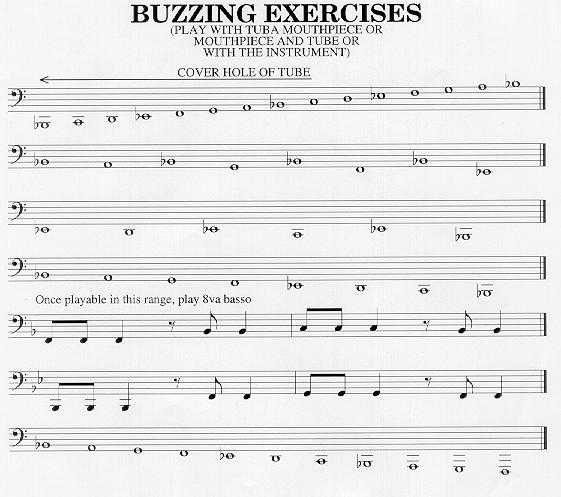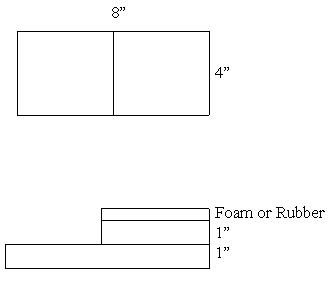TEACHING THE TUBA
(TIPS FOR THE BAND AND ORCHESTRA TEACHER)
by Scott Force
December 1996
WHO SHOULD BE SWITCHED TO TUBA
Trumpet, trombone, and baritone players are more inclined to find the switch to a low brass instrument easier than most woodwind players. Students should be well developed, physically active, and of average or higher intelligence. Thick lip construction is helpful, but not necessary.MAKING THE TRANSITION FROM TRUMPET, TROMBONE AND BARITONE
A trumpet student may be asked to play the treble clef baritone parts in the band with the trumpet. When the student feels comfortable playing a new part, switch them to the baritone horn. After the student is comfortable with the new voice, the student should start learning and reading bass clef. This will then make an easy switch to BB flat tuba.A trumpet student can easily switch directly to the E flat tuba. All the student has to do is read the music in treble clef, adding three flats. There are many used E flat tubas around collecting dust. With a little repair, the instrument will play well. The E flat has the added advantage of playing the high register more easily. It is important to note that for many years the band repertoire used both the BB flat and E flat in fifths and octaves with splendid results.
Trombone and bass clef baritone players can easily make the switch to tuba. Trumpet players may also go directly to BB flat tuba, but it will be more difficult getting used to the new instrument size, low pitch, and a new clef to read.
POSTURE
Good posture should be enforced at all times. Many performance problems are a result of bad posture. The student should sit up straight and hold the chin up so the throat is unrestricted. Students should not lean back into the chair. The student should sit on the end of a the chair with their thighs in a slightly downward angle. This allows for quick, unrestricted deep breaths.LAP TYPE HORN
In many cases a stand would be very helpful. If one is not available, you can make a platform on which to rest the instrument that would fit between the student's legs. This is simple and can be constructed out of blocks of wood(see tuba stand, at the end of the article). Many students using a lap instrument can hold the instrument on their legs when they are in the playing position. The teacher should make sure the receiver of the mouthpiece is directly lined up to the student's mouth.AIR SUPPORT
A young tuba player will have an airy sound sometimes like a buzzing "whirrr" that can be explained as a lack of air support. Playing all brass instruments is 80% air and 20% chops. A well supported air stream will strengthen the embouchure and a weak one will damage it. This will lead to all kinds of crutches only to produce a poor tone. Playing the tuba does not take a lot of air pressure, but it does require moving a large volume of air constantly, especially in the low register. The best way to get a young student used to moving a large volume of air is to sing the phrases musically on the syllable "la," and then play it. A good reference to this topic is the book, Arnold Jacobs, The Legacy Of A Master, published by Instrumental Publishing Company, 1987.INCREASING RANGE AND IMPROVING TONE AND PITCH
Due to the large volume of air that is required to play the instrument, and the low amount of resistance, a good amount of supervised buzzing on the mouthpiece alone can produce wonderful results. When the student is working in the high range, it is very easy to find the proper amount of air pressure to support the buzz. In the low to extremely low register, placing the tip of the finger over the end of the mouthpiece will adjust the back pressure to duplicate the instrument's natural resistance.Using the syllables "tu/ee" ascending and "tu/aah" descending with little facial movement in either direction, will aid in sensitizing the lips while allowing the proper amount of breath support to develop new pitches in either direction. It is also important to have the student add a double whole note at the end of each scale.
NO TUBA AT HOME
One of the disadvantages of play tuba is the overwhelming size and lack of ease of transportation. Many schools cannot afford to let a student keep one instrument at home while another at school. Here is a great example of how to practice the tuba without the entire instrument at home:Go to your local hardware store and purchase a piece of clear rubber tube, 5/8 inch outside diameter, 1/2 inch inside diameter. Cut the tube eighteen inches in length. Place the tube in the freezer. When it becomes rigid, take it out and drill an eighth of an inch hole through one side only, about one and one half inches from one end. Insert the tuba mouthpiece into the tube. This tube can be used to practice all music and/or exercises covering the hole in the medium to low range. Cover the hole from the second space C down(see ex. one).
DEVELOPING HIGH AND LOW PITCHES
To develop the high and low range, first have the students play the notes in the medium, comfortable range. When they can easily play the music, and they have the pitches in their head, ask them to play the music as it is written.BASS CLEF FINGERINGS
Learning new fingerings and reading a new clef can be a problem for some students. Do not have the student playing both bass and treble clef at the same time. Make the break to bass clef all at one time. Use easy music to get used to new notes and fingerings. If you will pick songs from the beginning book, it will be easier for them to adapt. Scale study is also an excellent way to train students to become familiar to bass clef and the new fingerings. You may want to tell the students who played treble clef that the tuba uses the same fingerings, but only one note higher(ex. Bb on the tuba is played like the trumpet playing C(no valves)).TEACHING STEADY RHYTHM
A basic program to teach rhythm is known as S.F.P: Say it, Finger it, Play it. Have the student keep a steady beat with their foot while saying the name of the note in time, or on the syllable "la" with the correct rhythm. After they can accomplish this project, have them tap their foot, say the name of the notes, while fingering the notes on the instrument. Then it is time to play it while they tap their feet. By focusing on only a few behaviors at time, it will help the student develop their reading ability, hear rhythmically, and improve pitch. After a while, reading rhythms will become a subconscious process such as reading out loud.BREATHING
Have your students bring in an empty paper towel or toilet paper roll. Let them use the paper roll to breath though before they play. The size of the roll will help them sense the true open throat with which they want to breath.BUZZING EXERCISES/TUNING
At the end of this article are some exercises that will increase range and tone. Once the student has developed a controlled sound, it is time to work on tuning. Practicing the Bb scale with a tuner may be helpful. As the students get better, you may want to show them how to pull certain slides for key pitches. Do not wait to long to discuss tuning. The earlier they start listening to pitch the easier it will be for them to play in tune.MOUTHPIECE SELECTION
There are many mouthpieces on the market. The rim can be either flat, rounded, or a combination of both. Its shape is important for comfort and ease of holding the proper placement of the embouchure. A flat rim is better for large lips. The contour of the cup is another consideration. A younger student needs a shallower cupped mouthpiece while the more mature student will find the V shape more desirable. A shallow cup with a rounded rim with have a better response for a player with thin lips. The bore of the mouthpiece will effect the tone, response, and pitch. Beginners will probably be more successful with a small bore.DEVELOPING INTEREST IN THE TUBA
One of the reasons that instruments become popular is the visibility in personal performance and television. If you have a stageband in your school, have the tuba perform on some of the arrangements. Let the instrument be heard and seen. A band program with featured low brass can really get the crowd excited. There are many local brass quintet and tuba quartets that can provide stimulating programs that would inspire current and future players. Live musical performances are very practical and affordable especially when exercised with Music Performance Trust Funds at your local musician's union.TUBA STAND (FOR CHAIR)
Materials:
- 1 piece 1" x 4" x 8" pine
- 1 piece 1" x 4" x 4" pine
- 1 piece of 4" x 4" rubber or foam
Note: Width and length of stand may be cut to individual size of student to fit between the legs of player, being placed on chair
BUZZING EXCERSIZES





